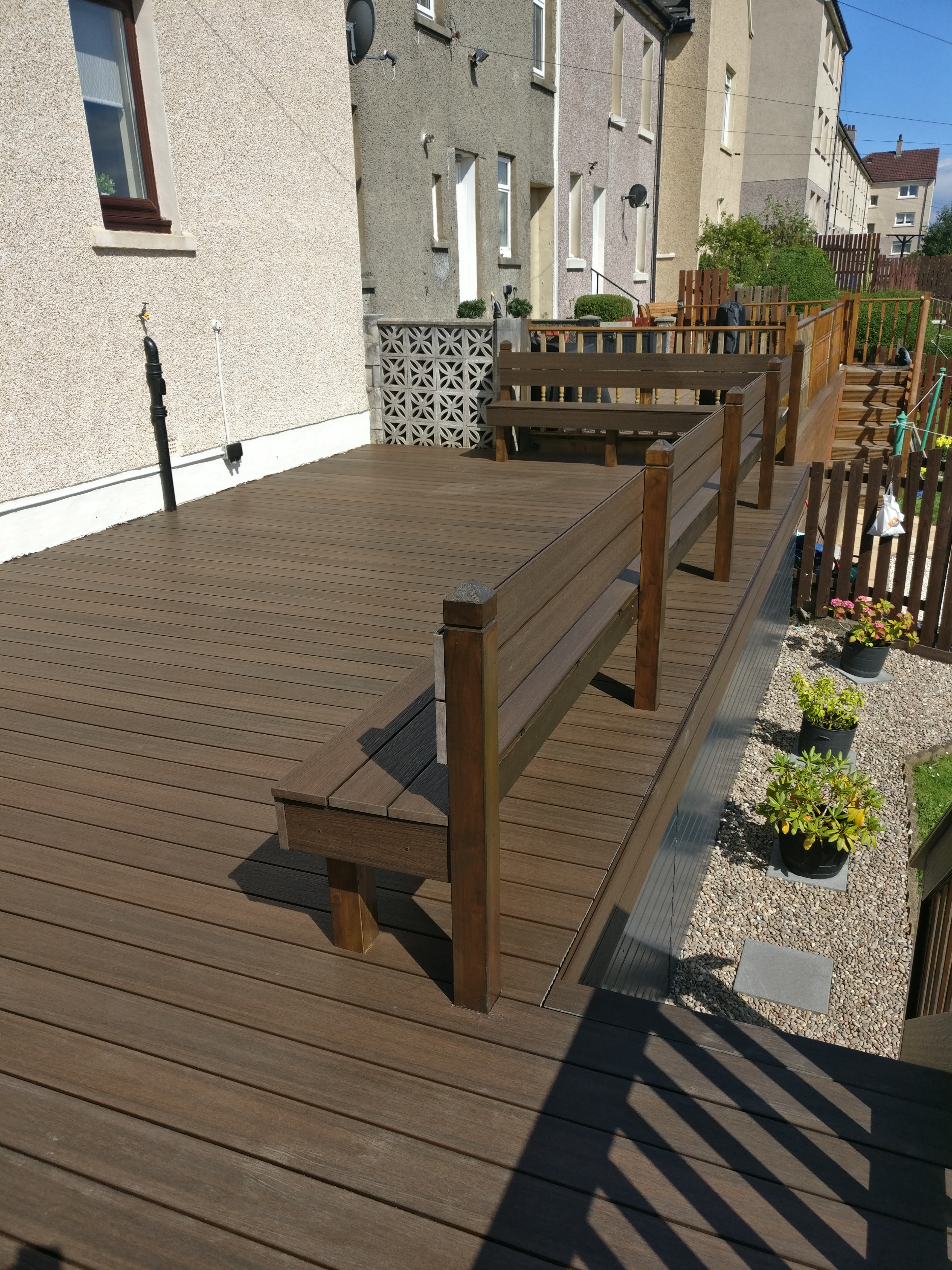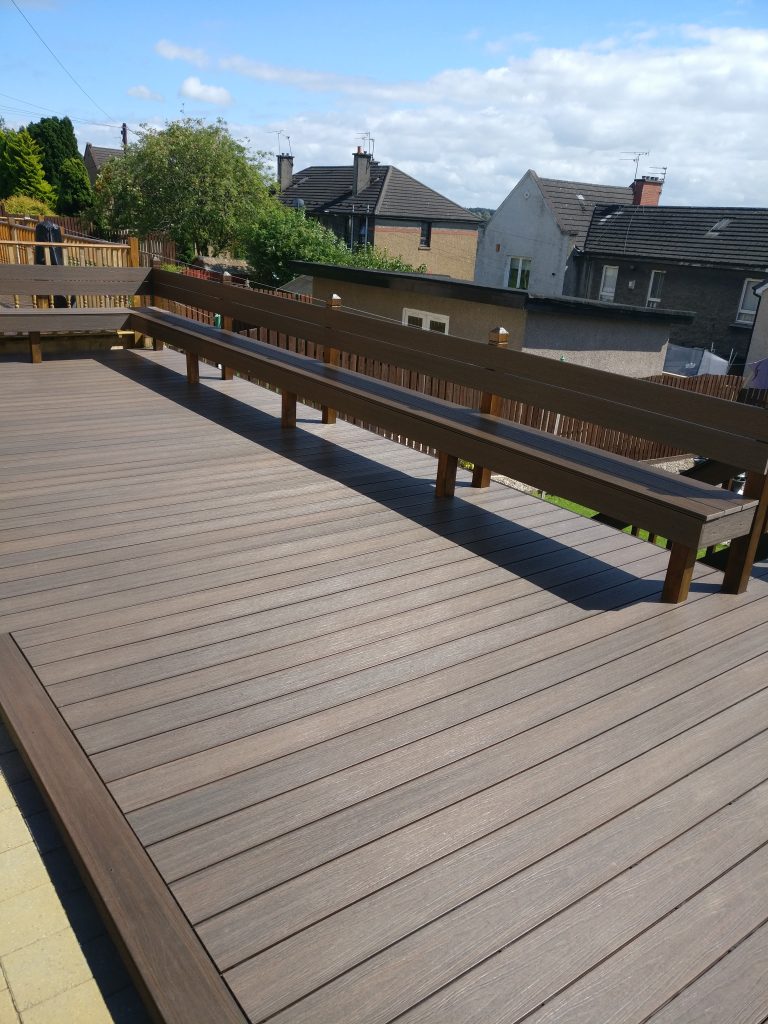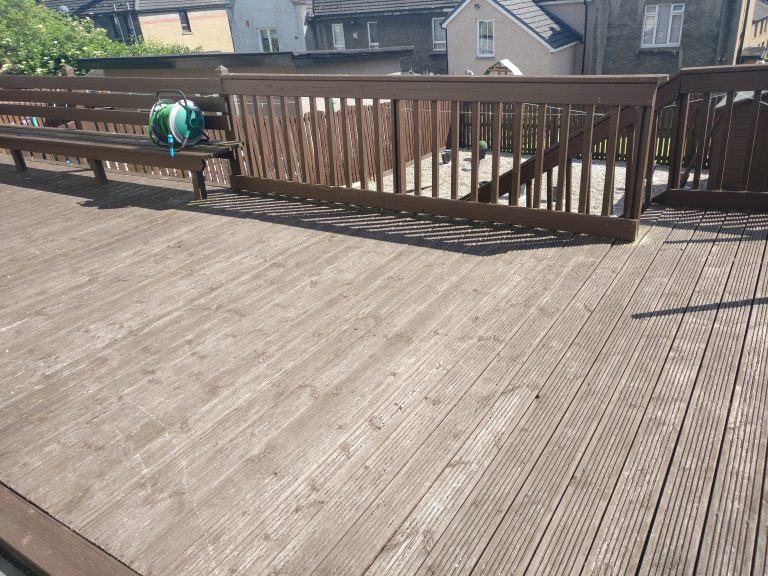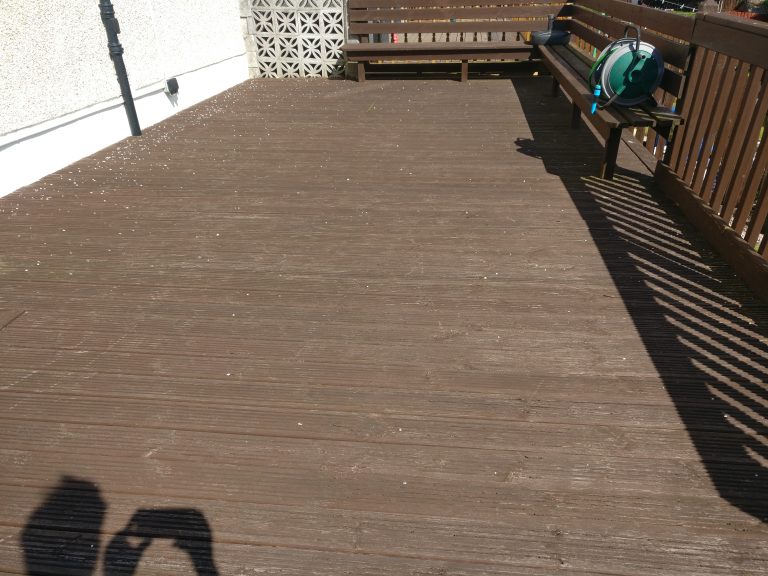Composite decking has become an increasingly popular choice for outdoor spaces due to its low maintenance, durability, and eco-friendly nature. One common concern among homeowners and builders is how well composite decking handles water drainage. In this article, we’ll explore the water drainage capabilities of composite decking, how it is affected by various factors, and ways to improve drainage. We’ll discuss alternatives to composite decking that may offer better water drainage.
Whether you’re considering installing a new deck or looking to enhance the drainage of your existing composite deck, this comprehensive guide will provide you with the knowledge and insights you need.
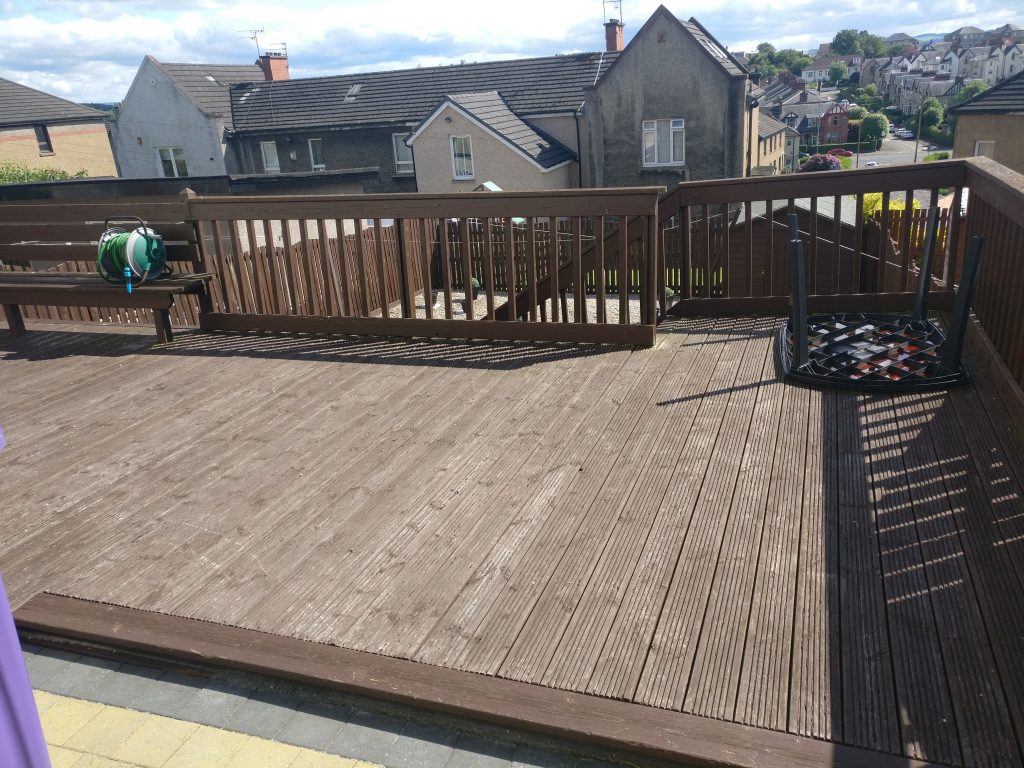
What Is Composite Decking?
Composite decking is an outdoor construction material designed for use in backyard deck installations, offering a durable and aesthetically pleasing alternative to traditional wood or PVC decking.
It is composed of a blend of wood fibres, plastic, and binding agents, creating a resilient and low-maintenance material that can withstand harsh outdoor conditions. Its resistance to fading, staining, and scratching makes it a popular choice for outdoor use, requiring minimal upkeep and offering long-lasting performance.
Composite decking comes in a variety of colours and textures, providing a customisable and attractive option for enhancing outdoor living spaces and adding value to homes. Its versatility and eco-friendly qualities make it a preferred choice for modern deck construction.
How is composite decking made?
Composite decking is manufactured using a blend of composite materials, such as wood fibres and plastic, to create a durable and environmentally sustainable decking product.
These materials are often sourced from recycled or reclaimed sources, making composite decking an eco-friendly choice for outdoor spaces. The manufacturing process involves combining the wood and plastic components using advanced construction techniques, such as extrusion and co-extrusion, to ensure a uniform and strong composite. This results in a decking material that is resistant to rot, decay, and insect damage, providing a longer lifespan than traditional wood decking.
The use of composite materials reduces the reliance on natural timber resources, contributing to the conservation of forests and promoting environmental sustainability.
What are the benefits of composite decking?
Composite decking offers a multitude of benefits, enhancing outdoor living spaces with its exceptional performance, sustainable design, and appealing aesthetics.
Low Maintenance
One of the key benefits of composite decking is its low maintenance requirements, reducing the need for extensive cleaning, sealing, and preserving, whilst offering an extended lifespan.
This makes it an appealing choice for homeowners who want to enjoy the beauty of a deck without the hassle of constant upkeep. Unlike traditional wood decks, composite decking typically does not require staining, painting, or sealing to maintain its appearance and structural integrity.
The extended lifespan of composite decking means that homeowners can enjoy their outdoor living space for years to come, without the need for constant repairs and replacements.
Durable and Long-lasting
Composite decking exhibits exceptional durability and long-lasting performance, withstanding weathering effects and maintaining structural integrity, often backed by comprehensive warranty coverage.
This durability is a result of its resistance to moisture, fading, and insect damage, making it an ideal choice for outdoor spaces. The structural integrity of composite decking ensures that it maintains its shape and strength over time, even in varying weather conditions. The inclusion of comprehensive warranty coverage provides homeowners with peace of mind, knowing that their investment is protected against potential defects or issues.
Composite decking offers a reliable and durable solution for outdoor living areas, extending its appeal and value to homeowners.
Environmentally Friendly
Composite decking is recognised for its environmentally friendly composition, incorporating sustainable elements and demonstrating exceptional water resistance in various environmental factors.
This sustainable alternative to traditional wood decking is typically made from a blend of recycled wood fibres and plastic, reducing the demand for virgin materials and diverting waste from landfills. The incorporation of recycled material not only conserves natural resources but also helps in reducing the carbon footprint associated with traditional decking materials.
Its inherent water resistance not only prolongs the lifespan of the decking but also minimises the need for potentially harmful chemical treatments, further supporting sustainability and environmental conservation efforts.
Does Water Drain Through Composite Decking?
A common query regarding composite decking revolves around its water drainage capabilities, addressing concerns about water absorption, effective drainage, and moisture management.
Many homeowners seek durable decking materials that offer a high level of water resistance and effective moisture management. Composite decking, often praised for its low maintenance needs, undergoes rigorous testing to ensure it meets industry standards for water absorption and drainage efficacy.
Innovations in composite decking technology have led to materials with improved water-shedding properties and enhanced moisture management systems, giving homeowners peace of mind when it comes to safeguarding their outdoor living spaces against water damage and moisture-related issues.
What Is The Water Drainage System Of Composite Decking?
The water drainage system of composite decking encompasses features such as surface texture and design considerations that facilitate efficient water runoff and management.
The surface texture of composite decking plays a crucial role in ensuring effective water drainage. The carefully engineered texture provides adequate grip while allowing water to flow off the surface without puddles or stagnant areas. The design elements, such as grooves and channels, further assist in directing water towards the edges, preventing any accumulation or damage to the decking material.
This comprehensive approach to water management enhances the longevity and functionality of composite decking in various weather conditions.
What factors influence water drainage in composite decking?
Several factors influence the water drainage in composite decking, including the deck’s gradient, the quality of installation, and the environmental impact on the decking material and property.
A deck’s gradient plays a crucial role in directing water away from the surface. Proper installation, such as the use of specialised fasteners and ensuring precise alignment of the composite boards, also affects drainage. Surrounding environmental factors, like trees or landscaping, can impact the flow of water on the deck. It’s important to consider these factors to maintain proper drainage and prevent water-related issues such as standing water or structural damage.
Slope and Pitch of the Deck
The gradient and incline of the deck significantly influence the effectiveness of water drainage and management, impacting the property’s overall moisture control and drainage capabilities.
These factors play a crucial role in directing rainwater away from the deck and foundation, preventing potential water damage and erosion. Depending on the gradient and incline, water can either gather on the deck, leading to stagnant water issues, or efficiently flow away from the structure, promoting proper drainage. Proper gradient and incline adjustments can enhance the overall functionality of the deck area, ensuring that water drainage is effectively managed to protect the property from potential water-related issues.
Gaps Between Boards
The presence of gaps between composite decking boards can significantly affect water drainage, highlighting the importance of precise installation and its impact on surface water runoff and weathering.
This aspect is crucial for preventing water from pooling on the decking surface, as gaps allow for efficient runoff. Proper installation ensures uniform gaps, preventing water from accumulating and potentially causing damage to the decking material. Well-spaced composite boards aid in regulating moisture levels, reducing the likelihood of weathering and enhancing the longevity of the deck.
Incorporating precision during installation not only promotes effective water drainage but also contributes to the overall resilience of the decking against weather-related deterioration.
Quality of Installation
The quality of installation plays a pivotal role in determining the effectiveness of water drainage in composite decking, often influenced by the manufacturer and product specifications.
It is crucial for the installers to adhere to the manufacturer’s recommended guidelines for proper deck slope and gap spacing, as these specifications directly impact the drainage performance.
The use of compatible fasteners and accessories specified by the manufacturer can significantly affect the overall water drainage capabilities of the composite decking. By following these specifications diligently, one can ensure optimal water drainage and minimise the risk of water accumulation or related issues in composite decking installations.
How to Improve Water Drainage in Composite Decking?
Improving water drainage in composite decking involves adherence to proper installation practices, regular maintenance, and the strategic use of drainage mats or under-deck systems.
By following proper installation practices, including ensuring a slight slope for efficient water runoff, and regular maintenance such as clearing debris from gaps between the composite boards, the longevity of the decking can be maintained.
The strategic application of high-quality drainage mats or under-deck systems can effectively redirect water away from the decking surface, minimising the risk of moisture-related issues. These measures help to prevent water accumulation and enhance the overall performance and appearance of the composite decking.
Proper Installation
Ensuring proper installation of composite decking is essential for optimising water drainage, contributing to reduced maintenance requirements and potential warranty coverage.
It is crucial to pay attention to the slope and joist spacing during installation to allow for efficient water runoff, preventing water from pooling and potentially damaging the material. Correct installation not only ensures better drainage but also promotes airflow, reducing the likelihood of mould and mildew growth, which can impact the longevity of the deck.
Adhering to proper installation guidelines can also impact potential warranty coverage, as failure to follow recommended installation practices may void any warranty provided by the manufacturer. Therefore, investing in professional installation or diligently following installation instructions is imperative for long-term performance and warranty protection.
Regular Cleaning and Maintenance
Regular cleaning and maintenance routines are integral to improving water drainage in composite decking, extending the deck’s lifespan and preserving the initial investment.
This regular upkeep not only prevents water accumulation, which can lead to mold, mildew, and discoloration, but also maintains the structural integrity of the composite boards. When neglected, standing water can degrade the composite material and compromise the deck’s stability, leading to costly repairs or premature replacement.
By investing time in proper cleaning and maintenance, homeowners can effectively protect their initial investment and enjoy a durable, visually appealing deck for years to come.
Use of Drainage Mats or Under-Deck Systems
The strategic integration of drainage mats or under-deck systems can significantly improve water drainage in composite decking, managing water runoff and enhancing moisture control.
These innovative drainage solutions help mitigate the risk of water accumulation, preventing potential damage to the decking structure and minimising the growth of mould and mildew. By efficiently channelling water away from the deck, they contribute to a drier and safer outdoor living space while extending the longevity of the composite materials.
These systems promote proper ventilation, reducing the risk of moisture-related issues and adding to the overall comfort and aesthetics of the decking area.
What Are The Alternatives To Composite Decking For Better Water Drainage?
For improved water drainage, alternative decking options such as PVC, aluminium, and pressure-treated wood offer viable alternatives to composite decking, each with distinct water management properties.
PVC Decking
PVC decking presents itself as a compelling alternative with notable water drainage capabilities, emphasising its moisture resistance and suitability for efficient installation processes.
This type of decking material is designed to effectively repel moisture, making it suitable for areas with high humidity or near water features. Its innovative design allows for efficient water drainage, preventing water from accumulating and causing potential issues such as warping or mould growth.
The installation process for PVC decking is streamlined and straightforward, offering convenience for both homeowners and contractors. With its remarkable moisture resistance and easy installation, PVC decking proves to be a practical choice for outdoor spaces.
Aluminium Decking
Aluminium decking offers exceptional water drainage properties, showcasing its durability and minimal environmental impact, making it a favourable alternative for water-prone outdoor settings.
This feature not only ensures a dry and safe surface for outdoor activities but also prevents water accumulation, reducing the risk of moisture-related damage and mould growth. The durability of aluminium decking allows it to withstand harsh weather conditions, maintaining its structural integrity over time. Its resistance to rust and corrosion further contributes to its longevity, minimising the need for frequent replacements.
The recyclability of aluminium makes it an eco-friendly choice, as it can be repurposed at the end of its lifespan, reducing environmental impact.
Pressure-Treated Wood Decking
Pressure-treated timber decking, when appropriately maintained, can offer reasonable water drainage properties, although requiring diligent maintenance due to its natural material composition.
This type of decking, known for its resistance to decay and insects, is treated with preservatives to enhance its durability. Regular maintenance involving cleaning and resealing is crucial to maintain its water drainage potential.
The composition of pressure-treated timber, typically Southern yellow pine or other softwoods, ensures its ability to repel water. Due to its natural tendency to absorb and release moisture, diligent maintenance is vital to prevent warping, splitting, and decay.

